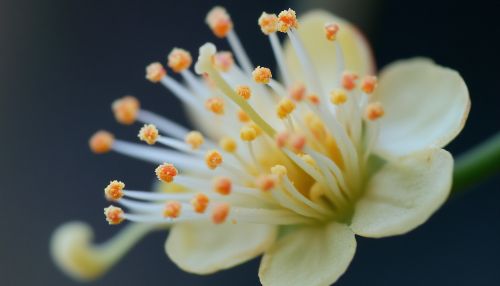Hermaphrodite: Difference between revisions
(Created page with "== Introduction == The term "hermaphrodite" refers to an organism possessing both male and female reproductive organs. This phenomenon occurs across various biological kingdoms, including plants, animals, and fungi. The concept of hermaphroditism is deeply rooted in the study of sexual reproduction, evolutionary biology, and genetics. While the term has been historically used in human contexts, it is now considered outdated and potentially offens...") |
No edit summary |
||
| Line 43: | Line 43: | ||
The evolutionary advantages of hermaphroditism in plants include increased reproductive assurance, especially in environments with limited pollinator availability. It also allows for greater genetic recombination and adaptability to changing environmental conditions. | The evolutionary advantages of hermaphroditism in plants include increased reproductive assurance, especially in environments with limited pollinator availability. It also allows for greater genetic recombination and adaptability to changing environmental conditions. | ||
[[Image:Detail-98533.jpg|thumb|center|Close-up of a hermaphroditic flower with both stamens and pistils visible.|class=only_on_mobile]] | |||
[[Image:Detail-98534.jpg|thumb|center|Close-up of a hermaphroditic flower with both stamens and pistils visible.|class=only_on_desktop]] | |||
== Hermaphroditism in Animals == | == Hermaphroditism in Animals == | ||
Latest revision as of 23:38, 18 October 2024
Introduction
The term "hermaphrodite" refers to an organism possessing both male and female reproductive organs. This phenomenon occurs across various biological kingdoms, including plants, animals, and fungi. The concept of hermaphroditism is deeply rooted in the study of sexual reproduction, evolutionary biology, and genetics. While the term has been historically used in human contexts, it is now considered outdated and potentially offensive when referring to humans, with "intersex" being the preferred term. However, in the context of other organisms, hermaphroditism remains a valid and widely used term.
Biological Basis of Hermaphroditism
Hermaphroditism is a reproductive strategy that can offer several evolutionary advantages. In environments where finding a mate is challenging, having both male and female reproductive organs allows an organism to self-fertilize or mate with any encountered individual. This flexibility can enhance reproductive success and genetic diversity.
Genetic Mechanisms
The genetic basis of hermaphroditism varies significantly across species. In some cases, it is controlled by specific genes that regulate the development of both male and female reproductive structures. For example, in the nematode C. elegans, hermaphroditism is determined by the expression of sex-determining genes such as tra-1 and fem-3. These genes orchestrate the development of both sperm and oocytes within the same individual.
Hormonal Regulation
Hormones play a crucial role in the regulation of hermaphroditic traits. In many fish species, such as the clownfish, sex change is hormonally controlled. The presence or absence of certain hormones can trigger the transformation from male to female or vice versa, allowing these fish to adapt to social and environmental conditions.
Types of Hermaphroditism
Hermaphroditism can be classified into several types based on the timing and nature of reproductive organ development.
Simultaneous Hermaphroditism
In simultaneous hermaphroditism, an organism possesses both male and female reproductive organs at the same time. This is common in many invertebrates, such as earthworms and some species of snails. These organisms can often self-fertilize, although cross-fertilization with another individual is typically preferred to increase genetic diversity.
Sequential Hermaphroditism
Sequential hermaphroditism involves an organism changing sex at some point in its life cycle. This can be further divided into two categories:
- **Protandry**: Individuals start life as males and later change to females. This is observed in species like the clownfish, where the dominant individual in a group becomes female.
- **Protogyny**: Individuals begin as females and later transition to males. This is seen in species such as the wrasse, where larger individuals become males to control a harem of females.
Hermaphroditism in Plants
In the plant kingdom, hermaphroditism is widespread and often referred to as "bisexuality." Most flowering plants are hermaphroditic, possessing both stamens (male organs) and pistils (female organs) within the same flower. This arrangement facilitates pollination and increases the likelihood of successful reproduction.
Mechanisms of Pollination
Hermaphroditic plants can self-pollinate or cross-pollinate. Self-pollination occurs when pollen from the same flower fertilizes the ovules, while cross-pollination involves pollen transfer between different flowers, often facilitated by wind, water, or pollinators like bees and birds.
Evolutionary Advantages
The evolutionary advantages of hermaphroditism in plants include increased reproductive assurance, especially in environments with limited pollinator availability. It also allows for greater genetic recombination and adaptability to changing environmental conditions.


Hermaphroditism in Animals
Hermaphroditism is prevalent in various animal taxa, particularly among invertebrates and some fish species. It is less common in mammals and birds.
Invertebrates
Many invertebrates, such as earthworms, slugs, and certain species of snails, exhibit simultaneous hermaphroditism. These organisms often engage in reciprocal mating, where both individuals exchange sperm, maximizing reproductive output.
Fish
Sequential hermaphroditism is well-documented in fish. Species like the parrotfish and wrasses exhibit complex social structures where sex change is a strategic response to social dynamics. This adaptability can enhance reproductive success and maintain population stability.
Amphibians and Reptiles
While less common, hermaphroditism has been observed in some amphibians and reptiles. Certain species of frogs and lizards can exhibit hermaphroditic traits, often as a response to environmental pressures or population density.
Hermaphroditism in Fungi
Fungi exhibit a unique form of hermaphroditism, often referred to as "homothallism." In homothallic fungi, a single organism can produce both male and female gametes, allowing for self-fertilization. This reproductive strategy is advantageous in environments where finding a compatible mate is challenging.
Genetic and Environmental Influences
The expression of hermaphroditic traits in fungi is influenced by both genetic and environmental factors. Certain genes regulate the development of reproductive structures, while environmental conditions such as nutrient availability and temperature can impact reproductive success.
Ecological and Evolutionary Implications
Hermaphroditism offers several ecological and evolutionary benefits, including increased reproductive flexibility and adaptability to changing environments. It allows organisms to optimize their reproductive strategies based on social and environmental conditions, enhancing their chances of survival and reproduction.
Genetic Diversity
Hermaphroditism can promote genetic diversity through mechanisms such as cross-fertilization and sex change. By facilitating genetic recombination, hermaphroditic organisms can adapt more readily to environmental changes and resist diseases and parasites.
Population Dynamics
In species with complex social structures, hermaphroditism can influence population dynamics by allowing individuals to change sex in response to social cues. This can help maintain a balanced sex ratio and ensure reproductive success in fluctuating environments.
Ethical and Social Considerations
While hermaphroditism is a natural and widespread phenomenon in many organisms, its application to humans is fraught with ethical and social considerations. The term "hermaphrodite" is considered outdated and potentially offensive when referring to humans, with "intersex" being the preferred term. Intersex individuals may face social stigma and discrimination, highlighting the need for increased awareness and understanding of human diversity.
